Zhi Tu
DL3DV-10K: A Large-Scale Scene Dataset for Deep Learning-based 3D Vision
Dec 29, 2023



Abstract:We have witnessed significant progress in deep learning-based 3D vision, ranging from neural radiance field (NeRF) based 3D representation learning to applications in novel view synthesis (NVS). However, existing scene-level datasets for deep learning-based 3D vision, limited to either synthetic environments or a narrow selection of real-world scenes, are quite insufficient. This insufficiency not only hinders a comprehensive benchmark of existing methods but also caps what could be explored in deep learning-based 3D analysis. To address this critical gap, we present DL3DV-10K, a large-scale scene dataset, featuring 51.2 million frames from 10,510 videos captured from 65 types of point-of-interest (POI) locations, covering both bounded and unbounded scenes, with different levels of reflection, transparency, and lighting. We conducted a comprehensive benchmark of recent NVS methods on DL3DV-10K, which revealed valuable insights for future research in NVS. In addition, we have obtained encouraging results in a pilot study to learn generalizable NeRF from DL3DV-10K, which manifests the necessity of a large-scale scene-level dataset to forge a path toward a foundation model for learning 3D representation. Our DL3DV-10K dataset, benchmark results, and models will be publicly accessible at https://dl3dv-10k.github.io/DL3DV-10K/.
Rapid Image Labeling via Neuro-Symbolic Learning
Jun 18, 2023



Abstract:The success of Computer Vision (CV) relies heavily on manually annotated data. However, it is prohibitively expensive to annotate images in key domains such as healthcare, where data labeling requires significant domain expertise and cannot be easily delegated to crowd workers. To address this challenge, we propose a neuro-symbolic approach called Rapid, which infers image labeling rules from a small amount of labeled data provided by domain experts and automatically labels unannotated data using the rules. Specifically, Rapid combines pre-trained CV models and inductive logic learning to infer the logic-based labeling rules. Rapid achieves a labeling accuracy of 83.33% to 88.33% on four image labeling tasks with only 12 to 39 labeled samples. In particular, Rapid significantly outperforms finetuned CV models in two highly specialized tasks. These results demonstrate the effectiveness of Rapid in learning from small data and its capability to generalize among different tasks. Code and our dataset are publicly available at https://github.com/Neural-Symbolic-Image-Labeling/
Speech Drives Templates: Co-Speech Gesture Synthesis with Learned Templates
Aug 18, 2021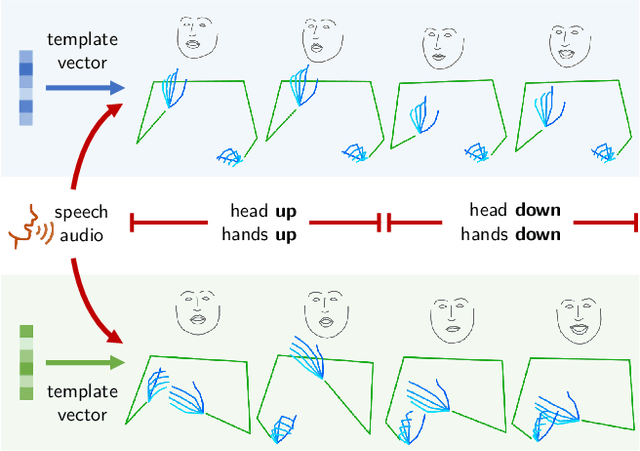
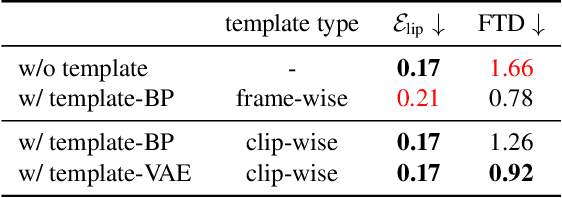


Abstract:Co-speech gesture generation is to synthesize a gesture sequence that not only looks real but also matches with the input speech audio. Our method generates the movements of a complete upper body, including arms, hands, and the head. Although recent data-driven methods achieve great success, challenges still exist, such as limited variety, poor fidelity, and lack of objective metrics. Motivated by the fact that the speech cannot fully determine the gesture, we design a method that learns a set of gesture template vectors to model the latent conditions, which relieve the ambiguity. For our method, the template vector determines the general appearance of a generated gesture sequence, while the speech audio drives subtle movements of the body, both indispensable for synthesizing a realistic gesture sequence. Due to the intractability of an objective metric for gesture-speech synchronization, we adopt the lip-sync error as a proxy metric to tune and evaluate the synchronization ability of our model. Extensive experiments show the superiority of our method in both objective and subjective evaluations on fidelity and synchronization.
Liquid Warping GAN with Attention: A Unified Framework for Human Image Synthesis
Nov 23, 2020



Abstract:We tackle human image synthesis, including human motion imitation, appearance transfer, and novel view synthesis, within a unified framework. It means that the model, once being trained, can be used to handle all these tasks. The existing task-specific methods mainly use 2D keypoints to estimate the human body structure. However, they only express the position information with no abilities to characterize the personalized shape of the person and model the limb rotations. In this paper, we propose to use a 3D body mesh recovery module to disentangle the pose and shape. It can not only model the joint location and rotation but also characterize the personalized body shape. To preserve the source information, such as texture, style, color, and face identity, we propose an Attentional Liquid Warping GAN with Attentional Liquid Warping Block (AttLWB) that propagates the source information in both image and feature spaces to the synthesized reference. Specifically, the source features are extracted by a denoising convolutional auto-encoder for characterizing the source identity well. Furthermore, our proposed method can support a more flexible warping from multiple sources. To further improve the generalization ability of the unseen source images, a one/few-shot adversarial learning is applied. In detail, it firstly trains a model in an extensive training set. Then, it finetunes the model by one/few-shot unseen image(s) in a self-supervised way to generate high-resolution (512 x 512 and 1024 x 1024) results. Also, we build a new dataset, namely iPER dataset, for the evaluation of human motion imitation, appearance transfer, and novel view synthesis. Extensive experiments demonstrate the effectiveness of our methods in terms of preserving face identity, shape consistency, and clothes details. All codes and dataset are available on https://impersonator.org/work/impersonator-plus-plus.html.
Sparse-GAN: Sparsity-constrained Generative Adversarial Network for Anomaly Detection in Retinal OCT Image
Jan 07, 2020
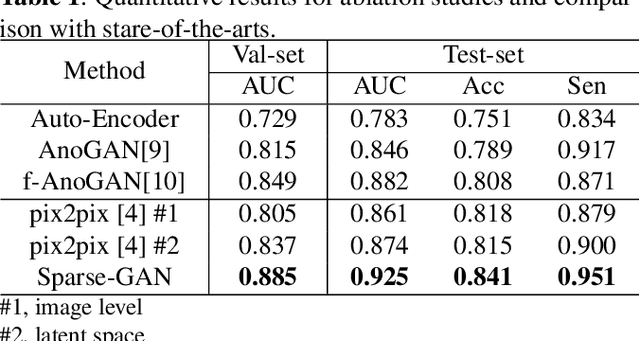
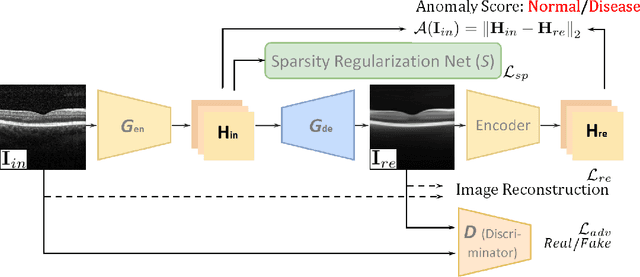
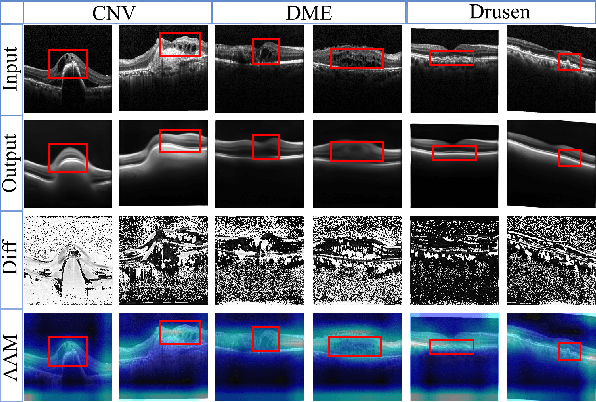
Abstract:With the development of convolutional neural network, deep learning has shown its success for retinal disease detection from optical coherence tomography (OCT) images. However, deep learning often relies on large scale labelled data for training, which is oftentimes challenging especially for disease with low occurrence. Moreover, a deep learning system trained from data-set with one or a few diseases is unable to detect other unseen diseases, which limits the practical usage of the system in disease screening. To address the limitation, we propose a novel anomaly detection framework termed Sparsity-constrained Generative Adversarial Network (Sparse-GAN) for disease screening where only healthy data are available in the training set. The contributions of Sparse-GAN are two-folds: 1) The proposed Sparse-GAN predicts the anomalies in latent space rather than image-level; 2) Sparse-GAN is constrained by a novel Sparsity Regularization Net. Furthermore, in light of the role of lesions for disease screening, we present to leverage on an anomaly activation map to show the heatmap of lesions. We evaluate our proposed Sparse-GAN on a publicly available dataset, and the results show that the proposed method outperforms the state-of-the-art methods.
 Add to Chrome
Add to Chrome Add to Firefox
Add to Firefox Add to Edge
Add to Edge